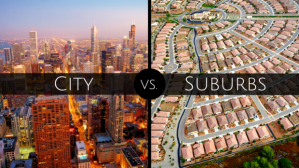 Although suburbs are characterized as having large, open plots of land covered in green space, the large-scale subdivisions that are completely dedicated to residential space are unsustainable and force its residents to contaminate the air by means of unnecessary car-dependency. It is very well known that the United States has become heavily dependent on cars over the course of the last 50 years, and as a result, a culture that revolves around driving and long commutes has given way to very serious public health issues. Issues like the large amount of greenhouse gasses being emitted and the long-term physical and mental health impacts of their residents are of great concern to informed citizens and policymakers who prioritize urban sustainability.
Although suburbs are characterized as having large, open plots of land covered in green space, the large-scale subdivisions that are completely dedicated to residential space are unsustainable and force its residents to contaminate the air by means of unnecessary car-dependency. It is very well known that the United States has become heavily dependent on cars over the course of the last 50 years, and as a result, a culture that revolves around driving and long commutes has given way to very serious public health issues. Issues like the large amount of greenhouse gasses being emitted and the long-term physical and mental health impacts of their residents are of great concern to informed citizens and policymakers who prioritize urban sustainability.
Time’s article tiled “The End of the Suburb” sheds light on issues that planners are facing today in regards to the spatial design and sustainability. The article states that “the American suburb used to evoke a certain way of life…Today’s suburb is more likely to evoke endless sprawl [and] a punishing commute…” Week 6’s reading titled “Physical Activity, Sprawl, and Health” addresses the issue of mental health among suburban communities that are not walkabe—such as most American suburbs.
Planners argue that walkable communities are those that are the most sustainable; they promote the physical well being of its residents, reduce carbon emissions, and reduce crime. It is for this reason that policy makers should push to create economic environments that promote walkability and urban sustainability; they would ultimately be working to help eliminate some of the most prominent health issues concerning our country. A city plan that promotes walkability and finding a suitable degree of density would make cities more sustainable and able to promote green living more easily.
Demonization of the American Suburb
http://ideas.time.com/2013/07/31/the-end-of-the-suburbs/
Finding the Right Urban Density—Not Too Little, Not Too Much:
http://switchboard.nrdc.org/blogs/kbenfield/city_density_isnt_the_issue_-.html
The Mental Health Costs of Sprawl:
“Physical Activity, Sprawl, and Health” Howard Frumkin, Lawrence Frank, Richard Jackson. 355.

Planners to me are like an artist, they just put up buildings or designs just for beauty without considering the long term health effects. Also, part of the blame also goes to we the residents, because everyone now want to live an urbanized life whereby everything is all about “beautification”. As Aldo Leopold once said, “we must all be land stewards”.
LikeLike
I agree with everything you said. Suburbs are definitely less “walkable” which will ultimately make it unsustainable if people are having to use cars to get around.
LikeLike
I completely agree with this post ! Desuburbanization and getting people, especially millenials back into the city is the only way to ensure a sustainable future for genreations to come. The key to a sustainable lifestyle is urban density. Besides the harmful effects driving has on the environment, and negatively effects obesity rates.
LikeLike